Sunday, 21 June 2009, Saulieu to Saint-Père-sous-Vezelay
Written 4 July 2009
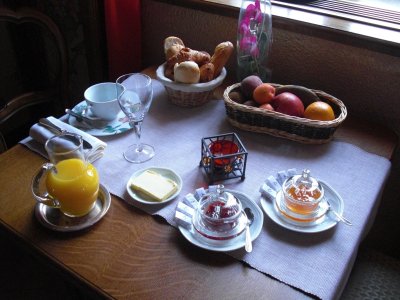 When we had arrived at the Hôtel de la Poste, no one was at the front desk. We had stood around for a moment or two, wondering whether we should look for a little bell to ring or something, before the chef emerged from the kitchen to give us our key and escort us to our room. For the rest of our time there, we saw no evidence that anybody else at all worked there. (Granted, things were slow; four other cars were parked in the courtyard, but only one other couple came to breakfast). He did a good job, though, as you can see from this photo of a breakfast table for one, by the light coming in through the window. The same chef emerged from the kitchen to take your order for coffee, tea, or chocolate.
When we had arrived at the Hôtel de la Poste, no one was at the front desk. We had stood around for a moment or two, wondering whether we should look for a little bell to ring or something, before the chef emerged from the kitchen to give us our key and escort us to our room. For the rest of our time there, we saw no evidence that anybody else at all worked there. (Granted, things were slow; four other cars were parked in the courtyard, but only one other couple came to breakfast). He did a good job, though, as you can see from this photo of a breakfast table for one, by the light coming in through the window. The same chef emerged from the kitchen to take your order for coffee, tea, or chocolate.
The breakfast was delicious, and to my delight, the background music was tuned to a radio station that was all accordion all the time! The female DJ was taking phoned-in requests for bal-musette classics; I don't know whether it was a special thing or a regular Sunday-morning phenomenon.
On the road again, we followed part of a Michelin-recommended driving tour toward our next destination, Saint-Père-sous-Vézelay, through more of the hilly-to-mountainous Morvan, over very small, very scenic roads. In places, the route numbers petered out, and the Michelin guide would say something like "turn left on the minor road that leaves the C48 just after the small bridge." Along the road, patches of large beeches and some oaks alternated with conifers and bracken. Ox-eye daisies, elderberry, and lots of purple foxgloves were in bloom. I saw some extraction logging (places where individual trees were cut, leaving the others) and a few very small clearcuts (no larger than, say, the footprint of our house in Tallahassee). Occasional European blue jays flew across our bow.
Where the trees gave way to agriculture, it was all hay or pasture for Charolais cattle, always small herds in large fields. No grapes and no grain (too steep for grain perhaps; nothing is too steep for grapes, so the soil must be wrong). I saw one group of six Holsteins. We enjoyed the scenery but didn't turn aside to visit the various churches and monuments mentioned in the guide. After crossing the Lac de St. Agnan on a causeway (near its narrow end), we passed the little road to the very isolated Abbaye de la Pierre-qui-vire, the Abbey of the Rocking Stone (apparently, Celts or somebody balanced a huge granite slab on a smaller rock; it's still there and rocks at the push of a hand). Again, we didn't turn in, but it was nice to find out where the cheese by that name comes from.
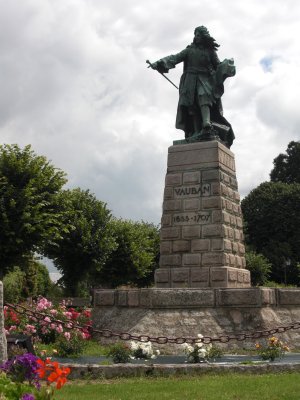 Along the way, we began to see signs advertising the birthplace of Vauban and a museum dedicated to him, in the nearby town of St. Leger-Vauban (it used to be St. Leger-somthing else, but they changed it in his honor). Who knew he was from around here?! The guidebook said the museum kept irregular hours, but we figured it was worth a try, and mirabile dictu, it was open. We were the only ones there. This statue of Vauban stands in the town center, just a few yards from the museum.
Along the way, we began to see signs advertising the birthplace of Vauban and a museum dedicated to him, in the nearby town of St. Leger-Vauban (it used to be St. Leger-somthing else, but they changed it in his honor). Who knew he was from around here?! The guidebook said the museum kept irregular hours, but we figured it was worth a try, and mirabile dictu, it was open. We were the only ones there. This statue of Vauban stands in the town center, just a few yards from the museum.
Vauban's actual birth name was Sébastien Le Prestre de Vauban. His grandfather, described as being of the "petit noblesse," had moved the family to St. Leger from the Cantal region, as a forestry expert, but despite the pretentions to nobility (the family name was "Le Prestre," but they claimed the right to add on the "de Vauban" because they were related to the family), the family was apparently pretty poor, and Sébastien grew up more or less as a peasant. He was born in 1633 and got his initial education from the local curate, then from a more erudite clergyman a little farther away. He showed such promise, especially in math, that his father actually sent him away to school for a while. In his late teens, he was presented to the Prince de Condé ( Le Grand Condé, in fact), the ruler of that part of the country (which wasn't actually part of France at the time), who agreed to take him on as a sort of apprentice military officer—about the only route out of the sticks for a country boy without money or connections. Within just a few years he'd risen considerably in the ranks when Condé lost a battle to Louis XIV and Sébastien was taken prisoner. Louis must already have known of him by reputation because he made him an offer—full pardon if you'll leave Condé and come work for me instead. Sébastien, to whom working for Condé was just a job, said "you're on." From that day, he was loyal to Louis, until he died in 1707, and he rose, purely on merit, to the position of Maréchal de France. Louis made him Marquis de Vauban.
The guy was brilliant. He's usually known as one of the all-time great military architects, but that's just the beginning of his accomplishments. Some examples, drawn from various periods of his life: (1) He convinced Louis that running from frontier to frontier, fighting whoever was there and trying to expand as far as possible in that direction while somebody else was taking territory from you on some other frontier was a mistake. The way to go was to mark out some nice natural boundaries (rivers, mountains, the sea), defining the size and shape of the country you wanted, to fortify those boundaries, and then to stay within them, mopping up any internal warlords and whatnot, until you had one solid lump of territory that could be yours forever, without constantly having to fight for it. The result was the present shape of France. (2) He saw the potential for artillery. He replaced bronze cannons with iron ones, and he devised siege strategies that could take any fortress in existence within 45 days, with much reduced casualties to the attackers (he said, "We need to burn more powder and spill less blood," and his troops adored him). (Of course, defender blood was another thing. He saw that the usual strategy for enfilading a trench lined with cannons—lobbing cannonballs into it on high arcs, so that most of them fell between enemy cannons and did little damage—was suboptimal. He trained his gunners to fire shots low and fast, just over the parapets, so that the cannonballs bounced and ricocheted along the trench taking out several guns and their crews with one shot. An opponent somewhere on the northern frontier was heard to remark "All these Medieval fortifications that have stood for centuries are now useless!" (3) His siege tactics required a great deal of mining and sapping, and he felt he was wasting too much time training beginners to do the digging, so he established the first permanent military engineering units, specialists who moved from siege to siege, doing the same job repeatedly and getting better and better at it. (4) He travelled constantly, 3000-8000 km/year, criss-crossing all of France, sometimes not getting home for five years at a time (we've seen his work in Lille, just south of Belgium, and in Villefranche, on the Mediterranean coast), and at the height of his career, he probably knew more about France than any man alive. (5) Above all, he hated wasting time, so he had a special mobile office built. It was like a large, enclosed sedan chair carried between two mules, fore and aft, and was fitted with an upholstered bench, fold-down desk, book case, brackets for candles, and writing and drafting supplies, so that he could write, revise, or work on building plans while he traveled from place to place. A troop of staff messengers travelled with him and were always galloping off with the latest plans or correspondence, then catching up later. (6) He devised new styles of fortification to replace the old "build a tall stone wall around the town" strategy. Because national boundaries were always shifting in those days, through conquest and through treaty, he several times besieged and took a city, refortified it to resist all known forms of attack including his own, saw it ceded back to the enemy by treaty, then had to go back a couple of years later, when hostilities flared again, to besiege and take it again! Both his friends and his enemies said, "A town besieged by Vauban is a town taken; a town defended by Vauban is a town retained." Towns took to capitulating when they saw him coming. (7) He improved canal and lock design for use all over France. (8) He devised a reformed tax code that was never adopted in his lifetime because it was so strongly resisted by the nobility (as being way too egalitarian) but was finally implemented at the time of the revolution. (8) He wasn't shy about inspecting the front lines personally and was wounded six times. Portraits and busts of him always show the scar on his left cheek, where he was shot in the face. Military engineers the world over regard his armor breastplate, covered with dents, almost as a holy icon. (9) He wrote an essay, backed up by extensive facts and calculations, recommending that French peasants raise pigs, as a way to promote prosperity and good nutrition. The list goes on and on. In summary, he has been described as a professional man of war who worked endlessly to promote not just peace but fair treatment and prosperity for all.
The museum, although small, was packed with information. In addition to the information on Vauban (divided up into Vauban the military engineer, Vauban the economist, and Vauban the thinker and reformer), it housed a large collection of lead soldiers. While we were there, a temporary exhibition was also in place—a descendent of Vauban's had toured the country making watercolor paintings of the many fortresses and bastions he had designed or built. The paintings have recently been published in book form, and the originals of many were on display.
 By the time we finished the museum it was after 1 p.m. (the place would probably have closed for lunch, but I suspect the lady at the desk just delayed her own break to let us finish), and noplace in St. Leger was still serving food, but the museum lady recommended a place run by friends of hers in the next town over, Quarré-les-Tombes (surnamed for a group of Roman tombs found there). We found our lunch at the Hôtel du Nord. The dining room was decorated with, among more conventional items, a large framed case, hung on the wall, full of antique electrical fittings and ceramic insulators.
By the time we finished the museum it was after 1 p.m. (the place would probably have closed for lunch, but I suspect the lady at the desk just delayed her own break to let us finish), and noplace in St. Leger was still serving food, but the museum lady recommended a place run by friends of hers in the next town over, Quarré-les-Tombes (surnamed for a group of Roman tombs found there). We found our lunch at the Hôtel du Nord. The dining room was decorated with, among more conventional items, a large framed case, hung on the wall, full of antique electrical fittings and ceramic insulators.
The place had slightly higher pretentions that your average café or brasserie—for the first time ever, we were served amuse-bouches at lunch: for each of us, a cheese gougère, a square of bread topped with tomato pesto and a tiny shrimp, and a square of bread with a piped rosette of liver paté topped by a pickle slice. Nice.
David's plate of jambon persillé came decorated with a heap of flavorful diced aspic and a radish rose, and in my salad of hot goat cheese, the cheese was wrapped in bacon, and the whole thing was thickly sprinkled with sesame seeds.

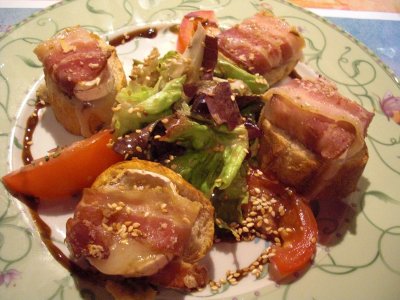 The French love to give businesses punning names, but in this place, they really got carried away—almost every business had a punning name. "Quarré" doesn't seem to mean anything in particular, but it's homonymous with "carré" ("square" or "downright"). The hairdresser was called "Coupe Quarré" (square cut), the candy shop was "Quarré au Chocolate" (chocolate square), the café across the street was "Quarré Crème" (a pun on "café crème," coffee with cream).
The French love to give businesses punning names, but in this place, they really got carried away—almost every business had a punning name. "Quarré" doesn't seem to mean anything in particular, but it's homonymous with "carré" ("square" or "downright"). The hairdresser was called "Coupe Quarré" (square cut), the candy shop was "Quarré au Chocolate" (chocolate square), the café across the street was "Quarré Crème" (a pun on "café crème," coffee with cream).
From Quarré we headed directly (or as directly as the scenic, twisty mountain roads permitted) to Saint-Père-sous-Vézelay. I had thought, from a mere viewing of the map, that that "sous" in the name meant that Saint-Père was "under" Vézelay in some administrative sense, but the truth turns out to be more literal. Vézelay is built on the narrow top of a very steep, rocky, isolated hill, and Saint-Père is the town at the bottom of the hill where everthing was built that wouldn't fit up there. Notably, a whole series of quite nice restaurants line the road right at the foot of the hill. Our dinner reservations were at l'Esperance ("hope"), the nicest of them, and our hotel La Renommée ("fame") was right next door. We thought, as usual, to drop our luggage at the hotel before going on into Vézelay to see the sights, but it was Sunday, and yes, this hotel too closed reception on Sunday afternoons. So we just started up the steep road to the peak. As we approached the top, a matter of a kilometer or two, we encountered a parking lot with a sign saying "Tourists, park here. Explore Vézelay on foot." It didn't actually say, "don't even think about parking in the town," but the implication was there. Unfortunately, we missed the turn, so we continued on, looking for a place to turn around, until we actually came out the other side of the town and encountered, duh, another parking lot, for folks arriving from the other direction. We parked there and started the steep climb from the parking lot to the street. Once at the street, we started the steep climb to the central axis of the town (at right angles to the road we had driven through on), and from there the road climbed, and climbed, and kept on climbing! It wasn't Rocadamour, or even Mont St. Michel, but it was a long and stiffish climb nonetheless!
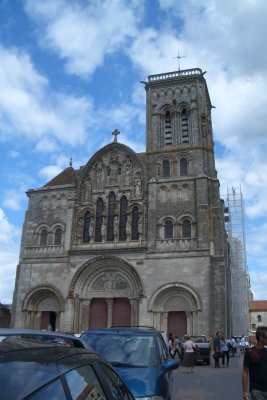
 The town's main attraction had made itself apparent long before we got there. The old Benedictine abbey church (now the Basilique Sainte-Marie-Madeleine) is perched on the highest point and is visible for miles across the surrounding plain in all directions. It was founded in the 9th century and is one of three or four major jumping-off points in France for the pilgrimage to Santiago de Compostela. Stylized scallop shells set in the pavement show the route.
The town's main attraction had made itself apparent long before we got there. The old Benedictine abbey church (now the Basilique Sainte-Marie-Madeleine) is perched on the highest point and is visible for miles across the surrounding plain in all directions. It was founded in the 9th century and is one of three or four major jumping-off points in France for the pilgrimage to Santiago de Compostela. Stylized scallop shells set in the pavement show the route.
The church is considered a gem of romanesque architecture, and "reading" all the images and allegories carved in the walls and column capitals is the study of years. A young monk was leading a tour, which we listened in on for a short while—he was spending a half-hour just explaining everything presented in a semicircular composition over one of the main doors from the narthex into the nave (photo below).
At Easter 1146, Bernard de Clairvaux (remember him?) came, at the invitation of the abbot, to preach the second crusade. Louis VII and Elinor of Aquitaine (that's the Elinor who later married Henry II, of The Lion in Winter) came to hear him, and he preached so effectively that Louis and Elinor actually went on the crusade, along with many thousands of their subjects. (Remember Katherine Hepburn's great line in the movie? "Louis had a stroke, and I almost died of windburn, but the troops were dazzled!"). In 1190, Richard I (the Lionhearted) and Philip II of France met and spent three months there before leaving on the third crusade.

 This column capital portrays a scene from the Bible, but I confess I've forgotten which one. The whole nave is lined with similar capitals, all showing different scenes.
This column capital portrays a scene from the Bible, but I confess I've forgotten which one. The whole nave is lined with similar capitals, all showing different scenes.
Perhaps most amazingly of all, halfway up the hill to the church, we encountered an explanatory signboard commemorating the final attempt to drill a well when the town was founded. They dug down 70 meters without ever finding water, so they gave up looking, but they continued building the abbey anyway! They constructed cisterns instead, to catch and store rainwater, and the abbey and the town were completely dependent on them (and any water they cared to carry up the hill from the river in Saint-Père) until the advent of modern plumbing.
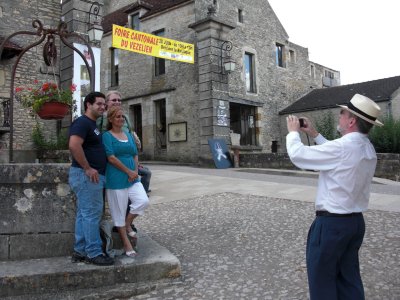
 We didn't have time for a full guided tour, so we just looked around on our own, with the aid of the Michelin green guide, then walked back down to the car. Near the bottom, David was asked by passing tourists to take a photo of them with their camera. The banner in the background advertises the Vézelay town fair, coming up in a week, to be held in an open park-like area behind the church.
We didn't have time for a full guided tour, so we just looked around on our own, with the aid of the Michelin green guide, then walked back down to the car. Near the bottom, David was asked by passing tourists to take a photo of them with their camera. The banner in the background advertises the Vézelay town fair, coming up in a week, to be held in an open park-like area behind the church.
By the time we got back down the hill, reception had opened, and we were shown to our room, which was on the ground floor and had its own little terrace with table, chairs, café umbrella.
At dinner time, we strolled next door to chef Marc Meneau's restaurant "l'Esperance" (GM 17/20). As usual, we were offered the chance to have our apperitif in the lounge, while we studied the menu, and David ordered a glass of champagne or a kir, I forget which. I was getting tired of just having water on these occasions, though, and I don't like to have anything as sweet as an orange juice (you need all the appetite you can muster for these dinners). The previous night I had noticed a young man with a group of friends who was drinking a mint syrup drink (perhaps he was the designated driver), so I ordered a "sirop de cassis." Imagine my astonishment when the bar didn't have cassis syrup! This is Burgundy! I thought there was a law! So I settled for a mint syrup instead—the most frequent choice of adults, in my experience. It was good, but I always find it a little embarrassing to be seen with a violently neon green drink by my plate.
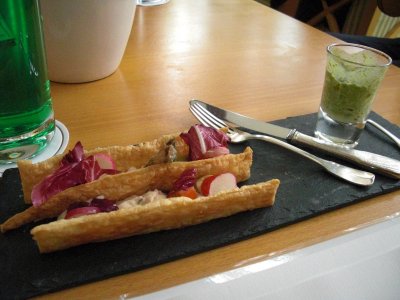
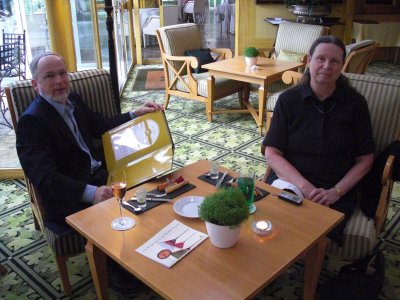 While we sipped our drinkgs and studied the menu, and then the wine list, which was about 1.5 inches thick (well, the pages were quick thick, too), they brought us the first amuse-bouche, and the waiter offered to take our picture. We chose the "Menu Arcimboldo."
While we sipped our drinkgs and studied the menu, and then the wine list, which was about 1.5 inches thick (well, the pages were quick thick, too), they brought us the first amuse-bouche, and the waiter offered to take our picture. We chose the "Menu Arcimboldo."
Amuse-bouche: A "millefeuille" (napoleon) of tuna, sardine, and mackerel with radicchio and little veggie bits and a glass of cold, fluffy lettuce-and-parsley soup. Both delicious! It was so elaborate they actually brought us knives and forks.
At the table, we were served special "beurre de barratte" from Pamplie, located in the Deux-Sèvres region, and the service plates had two kinds of ferns realisitically embossed on them. As in Saulieu, the dining room looked out on a beautiful garden. The central fountain featured a life-size statue of a girl reaching up over her head with both hands to grasp a duck with spread wings. We weren't sure whether she was catching it or launching it.

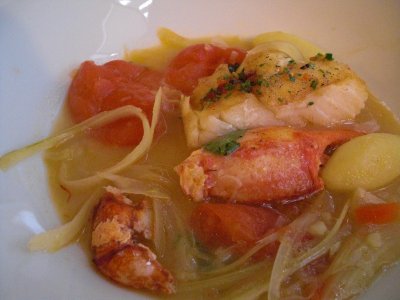 First course: "Preserved" cabbage leaves, with sandre, mozzarella and cucumber juice. That turned out to be, so far as we could tell, disks of a deliciously seasoned fish sausage, topped with small disks of mozzarella, and all sandwiched between perfectly round sheets of pressed, toasted cabbage. Across the middle of the plate were three coarse vegetable purées (bell pepper, cucumber, and something else). All wonderful!
First course: "Preserved" cabbage leaves, with sandre, mozzarella and cucumber juice. That turned out to be, so far as we could tell, disks of a deliciously seasoned fish sausage, topped with small disks of mozzarella, and all sandwiched between perfectly round sheets of pressed, toasted cabbage. Across the middle of the plate were three coarse vegetable purées (bell pepper, cucumber, and something else). All wonderful!
Second course: "Cataplaña" of dried salt cod and lobster. We had no idea what that would be, but it turned out to be a short of bouilabaise-like stew of cod, lobster, tomatoes, potatoes, and fennel. It arrived in a copper pot hinged like a clamshell and was deftly divided between two bowls by the server, at the table. With it came, for each of us (no fighting) a little bowl of golden saffron aioli, to be spooned into the stew to taste (or, in our case, every last drop). Wow, was that good!

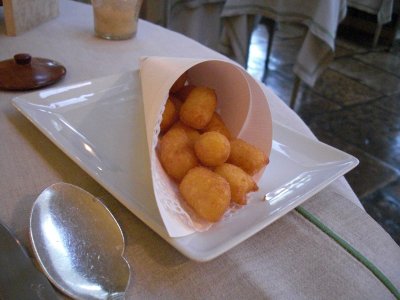 Third course: Filet of young female duckling with cherries, served with (again for each of us) a little stiff paper cone of potatoes "Lorette." On the plate with the duck was a long, skinny piece of toast topped with spinach and bits of confit duck. The duck was wonderful, but the potatoes were out of this world! Apparently this treatment is a great classic that has been neglected of late—little clouds of incredibly fluffy and flavorful potato fried crisp on the outside and served very hot. My Larousse Gastronomique says that they differ from "dauphine" potatoes in that Lorette potatoes have cheese in them, but I'm not sure these did. Anyway, the Larousse Gastro gives the recipe, and I'm definitely going to have to try this at home!
Third course: Filet of young female duckling with cherries, served with (again for each of us) a little stiff paper cone of potatoes "Lorette." On the plate with the duck was a long, skinny piece of toast topped with spinach and bits of confit duck. The duck was wonderful, but the potatoes were out of this world! Apparently this treatment is a great classic that has been neglected of late—little clouds of incredibly fluffy and flavorful potato fried crisp on the outside and served very hot. My Larousse Gastronomique says that they differ from "dauphine" potatoes in that Lorette potatoes have cheese in them, but I'm not sure these did. Anyway, the Larousse Gastro gives the recipe, and I'm definitely going to have to try this at home!
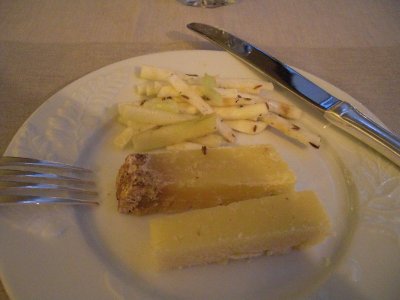
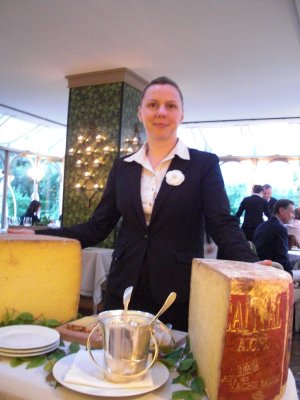 Cheese course: Cantal. The cheese trolley held only two choices: a 2006 "old Cantal" and a 2007 Cantal au Lait de Salers (made of milk from Salers cows, a large, chocolate-brown, long-horned breed). One was made in winter and the other in summer, and we were invited to try both, so as to compare them. I know which was summer and which was winter on my plate, but I lost track of which of those was 2006 and which 2007. They were both outstanding, though to my taste, I think the winter had a slight edge over the summer. They were served with a salad of strips of celery root and apple, flavored with whole cumin seed. With the cheese, David had his first chance to try the famous "yellow wine" of the Jura, but he didn't actually care for it.
Cheese course: Cantal. The cheese trolley held only two choices: a 2006 "old Cantal" and a 2007 Cantal au Lait de Salers (made of milk from Salers cows, a large, chocolate-brown, long-horned breed). One was made in winter and the other in summer, and we were invited to try both, so as to compare them. I know which was summer and which was winter on my plate, but I lost track of which of those was 2006 and which 2007. They were both outstanding, though to my taste, I think the winter had a slight edge over the summer. They were served with a salad of strips of celery root and apple, flavored with whole cumin seed. With the cheese, David had his first chance to try the famous "yellow wine" of the Jura, but he didn't actually care for it.
 Dessert was described as a composition of violet-flavored macaroons with crystallized rose petals and rose ice cream. As you can see from the photo, raspberries were also involved, and the whole thing was surrounded by a tangled wreath of spun sugar. The objects resting on it are crystallized violets and crystallized rose petals.
Dessert was described as a composition of violet-flavored macaroons with crystallized rose petals and rose ice cream. As you can see from the photo, raspberries were also involved, and the whole thing was surrounded by a tangled wreath of spun sugar. The objects resting on it are crystallized violets and crystallized rose petals.
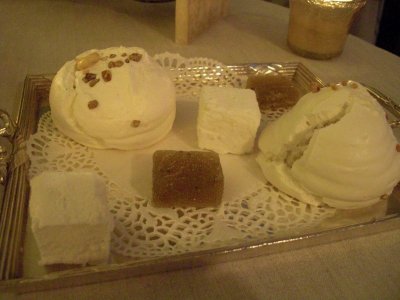 The mignardises included crisp meringues, house-made marshmallows, amber-colored fruit paste, little dishes of chocolate cream, spherical white-chocolate-covered truffles, small loaf cakes, and a big bowl of caramels and nougats..
The mignardises included crisp meringues, house-made marshmallows, amber-colored fruit paste, little dishes of chocolate cream, spherical white-chocolate-covered truffles, small loaf cakes, and a big bowl of caramels and nougats..
As we left the restaurant, the chef was in the lobby, so we had a chance to chat with him. He seemed surprised that we would choose to spend three weeks just in the Burgundy region. I even promised to send him the address of this diary. Both at the time and later in retrospect, David and I both remember this as the best overall dinner of the trip.
previous entry
List of Entries
next entry
 When we had arrived at the Hôtel de la Poste, no one was at the front desk. We had stood around for a moment or two, wondering whether we should look for a little bell to ring or something, before the chef emerged from the kitchen to give us our key and escort us to our room. For the rest of our time there, we saw no evidence that anybody else at all worked there. (Granted, things were slow; four other cars were parked in the courtyard, but only one other couple came to breakfast). He did a good job, though, as you can see from this photo of a breakfast table for one, by the light coming in through the window. The same chef emerged from the kitchen to take your order for coffee, tea, or chocolate.
When we had arrived at the Hôtel de la Poste, no one was at the front desk. We had stood around for a moment or two, wondering whether we should look for a little bell to ring or something, before the chef emerged from the kitchen to give us our key and escort us to our room. For the rest of our time there, we saw no evidence that anybody else at all worked there. (Granted, things were slow; four other cars were parked in the courtyard, but only one other couple came to breakfast). He did a good job, though, as you can see from this photo of a breakfast table for one, by the light coming in through the window. The same chef emerged from the kitchen to take your order for coffee, tea, or chocolate. Along the way, we began to see signs advertising the birthplace of Vauban and a museum dedicated to him, in the nearby town of St. Leger-Vauban (it used to be St. Leger-somthing else, but they changed it in his honor). Who knew he was from around here?! The guidebook said the museum kept irregular hours, but we figured it was worth a try, and mirabile dictu, it was open. We were the only ones there. This statue of Vauban stands in the town center, just a few yards from the museum.
Along the way, we began to see signs advertising the birthplace of Vauban and a museum dedicated to him, in the nearby town of St. Leger-Vauban (it used to be St. Leger-somthing else, but they changed it in his honor). Who knew he was from around here?! The guidebook said the museum kept irregular hours, but we figured it was worth a try, and mirabile dictu, it was open. We were the only ones there. This statue of Vauban stands in the town center, just a few yards from the museum. By the time we finished the museum it was after 1 p.m. (the place would probably have closed for lunch, but I suspect the lady at the desk just delayed her own break to let us finish), and noplace in St. Leger was still serving food, but the museum lady recommended a place run by friends of hers in the next town over, Quarré-les-Tombes (surnamed for a group of Roman tombs found there). We found our lunch at the Hôtel du Nord. The dining room was decorated with, among more conventional items, a large framed case, hung on the wall, full of antique electrical fittings and ceramic insulators.
By the time we finished the museum it was after 1 p.m. (the place would probably have closed for lunch, but I suspect the lady at the desk just delayed her own break to let us finish), and noplace in St. Leger was still serving food, but the museum lady recommended a place run by friends of hers in the next town over, Quarré-les-Tombes (surnamed for a group of Roman tombs found there). We found our lunch at the Hôtel du Nord. The dining room was decorated with, among more conventional items, a large framed case, hung on the wall, full of antique electrical fittings and ceramic insulators.
 The French love to give businesses punning names, but in this place, they really got carried away—almost every business had a punning name. "Quarré" doesn't seem to mean anything in particular, but it's homonymous with "carré" ("square" or "downright"). The hairdresser was called "Coupe Quarré" (square cut), the candy shop was "Quarré au Chocolate" (chocolate square), the café across the street was "Quarré Crème" (a pun on "café crème," coffee with cream).
The French love to give businesses punning names, but in this place, they really got carried away—almost every business had a punning name. "Quarré" doesn't seem to mean anything in particular, but it's homonymous with "carré" ("square" or "downright"). The hairdresser was called "Coupe Quarré" (square cut), the candy shop was "Quarré au Chocolate" (chocolate square), the café across the street was "Quarré Crème" (a pun on "café crème," coffee with cream).
 The town's main attraction had made itself apparent long before we got there. The old Benedictine abbey church (now the Basilique Sainte-Marie-Madeleine) is perched on the highest point and is visible for miles across the surrounding plain in all directions. It was founded in the 9th century and is one of three or four major jumping-off points in France for the pilgrimage to Santiago de Compostela. Stylized scallop shells set in the pavement show the route.
The town's main attraction had made itself apparent long before we got there. The old Benedictine abbey church (now the Basilique Sainte-Marie-Madeleine) is perched on the highest point and is visible for miles across the surrounding plain in all directions. It was founded in the 9th century and is one of three or four major jumping-off points in France for the pilgrimage to Santiago de Compostela. Stylized scallop shells set in the pavement show the route.
 This column capital portrays a scene from the Bible, but I confess I've forgotten which one. The whole nave is lined with similar capitals, all showing different scenes.
This column capital portrays a scene from the Bible, but I confess I've forgotten which one. The whole nave is lined with similar capitals, all showing different scenes.
 We didn't have time for a full guided tour, so we just looked around on our own, with the aid of the Michelin green guide, then walked back down to the car. Near the bottom, David was asked by passing tourists to take a photo of them with their camera. The banner in the background advertises the Vézelay town fair, coming up in a week, to be held in an open park-like area behind the church.
We didn't have time for a full guided tour, so we just looked around on our own, with the aid of the Michelin green guide, then walked back down to the car. Near the bottom, David was asked by passing tourists to take a photo of them with their camera. The banner in the background advertises the Vézelay town fair, coming up in a week, to be held in an open park-like area behind the church.
 While we sipped our drinkgs and studied the menu, and then the wine list, which was about 1.5 inches thick (well, the pages were quick thick, too), they brought us the first amuse-bouche, and the waiter offered to take our picture. We chose the "Menu Arcimboldo."
While we sipped our drinkgs and studied the menu, and then the wine list, which was about 1.5 inches thick (well, the pages were quick thick, too), they brought us the first amuse-bouche, and the waiter offered to take our picture. We chose the "Menu Arcimboldo."
 First course: "Preserved" cabbage leaves, with sandre, mozzarella and cucumber juice. That turned out to be, so far as we could tell, disks of a deliciously seasoned fish sausage, topped with small disks of mozzarella, and all sandwiched between perfectly round sheets of pressed, toasted cabbage. Across the middle of the plate were three coarse vegetable purées (bell pepper, cucumber, and something else). All wonderful!
First course: "Preserved" cabbage leaves, with sandre, mozzarella and cucumber juice. That turned out to be, so far as we could tell, disks of a deliciously seasoned fish sausage, topped with small disks of mozzarella, and all sandwiched between perfectly round sheets of pressed, toasted cabbage. Across the middle of the plate were three coarse vegetable purées (bell pepper, cucumber, and something else). All wonderful!
 Third course: Filet of young female duckling with cherries, served with (again for each of us) a little stiff paper cone of potatoes "Lorette." On the plate with the duck was a long, skinny piece of toast topped with spinach and bits of confit duck. The duck was wonderful, but the potatoes were out of this world! Apparently this treatment is a great classic that has been neglected of late—little clouds of incredibly fluffy and flavorful potato fried crisp on the outside and served very hot. My Larousse Gastronomique says that they differ from "dauphine" potatoes in that Lorette potatoes have cheese in them, but I'm not sure these did. Anyway, the Larousse Gastro gives the recipe, and I'm definitely going to have to try this at home!
Third course: Filet of young female duckling with cherries, served with (again for each of us) a little stiff paper cone of potatoes "Lorette." On the plate with the duck was a long, skinny piece of toast topped with spinach and bits of confit duck. The duck was wonderful, but the potatoes were out of this world! Apparently this treatment is a great classic that has been neglected of late—little clouds of incredibly fluffy and flavorful potato fried crisp on the outside and served very hot. My Larousse Gastronomique says that they differ from "dauphine" potatoes in that Lorette potatoes have cheese in them, but I'm not sure these did. Anyway, the Larousse Gastro gives the recipe, and I'm definitely going to have to try this at home!

 Cheese course: Cantal. The cheese trolley held only two choices: a 2006 "old Cantal" and a 2007 Cantal au Lait de Salers (made of milk from Salers cows, a large, chocolate-brown, long-horned breed). One was made in winter and the other in summer, and we were invited to try both, so as to compare them. I know which was summer and which was winter on my plate, but I lost track of which of those was 2006 and which 2007. They were both outstanding, though to my taste, I think the winter had a slight edge over the summer. They were served with a salad of strips of celery root and apple, flavored with whole cumin seed. With the cheese, David had his first chance to try the famous "yellow wine" of the Jura, but he didn't actually care for it.
Cheese course: Cantal. The cheese trolley held only two choices: a 2006 "old Cantal" and a 2007 Cantal au Lait de Salers (made of milk from Salers cows, a large, chocolate-brown, long-horned breed). One was made in winter and the other in summer, and we were invited to try both, so as to compare them. I know which was summer and which was winter on my plate, but I lost track of which of those was 2006 and which 2007. They were both outstanding, though to my taste, I think the winter had a slight edge over the summer. They were served with a salad of strips of celery root and apple, flavored with whole cumin seed. With the cheese, David had his first chance to try the famous "yellow wine" of the Jura, but he didn't actually care for it. Dessert was described as a composition of violet-flavored macaroons with crystallized rose petals and rose ice cream. As you can see from the photo, raspberries were also involved, and the whole thing was surrounded by a tangled wreath of spun sugar. The objects resting on it are crystallized violets and crystallized rose petals.
Dessert was described as a composition of violet-flavored macaroons with crystallized rose petals and rose ice cream. As you can see from the photo, raspberries were also involved, and the whole thing was surrounded by a tangled wreath of spun sugar. The objects resting on it are crystallized violets and crystallized rose petals. The mignardises included crisp meringues, house-made marshmallows, amber-colored fruit paste, little dishes of chocolate cream, spherical white-chocolate-covered truffles, small loaf cakes, and a big bowl of caramels and nougats..
The mignardises included crisp meringues, house-made marshmallows, amber-colored fruit paste, little dishes of chocolate cream, spherical white-chocolate-covered truffles, small loaf cakes, and a big bowl of caramels and nougats..